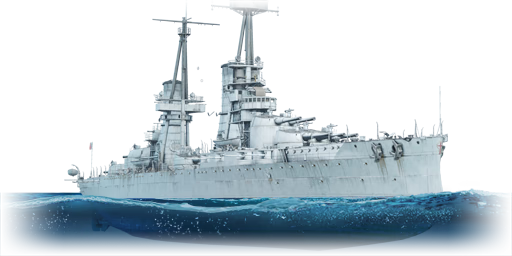The RN Andrea Doria was the lead ship of the Andrea Doria-class battleships, also referred to as the Duilio-class in Italian sources. The class consisted of the two ships Andrea Doria and Duilio, also referred to as Caio Duilio. The two ships were improved Conte di Cavour-class battleships and just like them, they shared the same main armament of thirteen 305 mm/46 Model 1909 guns. Secondary armament consisted of sixteen Ansaldo 152 mm/45 Model 1911 cannons and nineteen 76 mm QF-14 pdr Mk.I cannons together with three 450 mm torpedo tubes. Andrea Doria was named after 16th century Genoese admiral. She was launched on 30th March 1913 and completed on 13th March 1916. She saw little action during World War I. During the 1920s, she helped suppress rebels in Fiume and took part in the 1923 Corfu incident. Between 1937 and 1940, Andrea Doria underwent a refit just like her sister Duilio, changing her armament to two triple and two twin OTO 320 mm Model 1934 guns, four triple 135 mm/45 OTO 1937 cannons, ten 90 mm/53 Ansaldo anti-aircraft guns, six twin and three single 37 mm/54 Breda autocannons, and eight twin 20 mm Breda Model 35 autocannons, together with her torpedo tubes being removed. After the refit, Andrea Doria took part in the First Battle of Sirte during which she damaged the British K-class destroyer HMS Kipling with near misses. After the armistice was signed, on 9th September 1943, she sailed to internment at Malta where she remained until 8th June 1944, after which she returned to Taranto on 14th March 1945. After the war, she served as the flagship of the Italian Navy together with her sister Duilio. She was paid off on 16th September 1956 after serving for more than 40 years and broken up for scrap in La Spezia.
The RN Andrea Doria was introduced in Update "Drone Age" as the second dreadnought of the Regia Marina after RN Dante Alighieri. She is in her pre-refit configuration, featuring her original thirteen 305 mm gun configuration without the enhanced anti-air suite. Her armour is also quite weak compared to other battleships she faces. Unlike other ships, she does not possess HE shells in her arsenal. Her SAP shells have issues overpenetrating destroyers and some light cruisers as they require 17 mm of armour to fuze. The same fuze sensitivity is required for her APCBC shell, which also carries only 5.66 kg TNT as opposed to heavier payload of her contemporaries.















